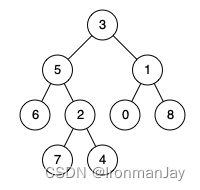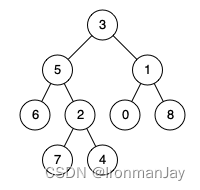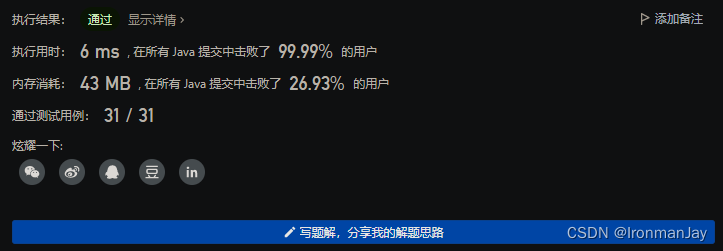一【题目类别】
- 深度优先搜索
二【题目难度】
- 中等
三【题目编号】
- 236.二叉树的最近公共祖先
四【题目描述】
- 给定一个二叉树, 找到该树中两个指定节点的最近公共祖先。
- 百度百科中最近公共祖先的定义为:“对于有根树 T 的两个节点 p、q,最近公共祖先表示为一个节点 x,满足 x 是 p、q 的祖先且 x 的深度尽可能大(一个节点也可以是它自己的祖先)。”
五【题目示例】
-
示例 1:

- 输入:root = [3,5,1,6,2,0,8,null,null,7,4], p = 5, q = 1
- 输出:3
- 解释:节点 5 和节点 1 的最近公共祖先是节点 3 。
-
示例 2:

- 输入:root = [3,5,1,6,2,0,8,null,null,7,4], p = 5, q = 4
- 输出:5
- 解释:节点 5 和节点 4 的最近公共祖先是节点 5 。因为根据定义最近公共祖先节点可以为节点本身。
-
示例 3:
- 输入:root = [1,2], p = 1, q = 2
- 输出:1
六【解题思路】
- 这个题本来想利用数组根据下标去找公共祖先,但是这显然是不允许的,以为题目给的二叉树并不是完全二叉树
- 那么我们就需要换一个思路
- 我们首先遍历这棵树,判断是否能找到题目给定的节点(p=left,q=right),一共分四种情况
- left和right都不为空:说明p和q异侧,root就是最近的公共祖先,返回root
- left和right都为空:说明二叉树中不存在p和q,返回null
- left不为空right为空:p和q同侧(left侧),最近公共祖先在left,返回left
- right不为空left为空:p和q同侧(right侧),最近公共祖先在right,返回right
七【题目提示】
- 树中节点数目在范围 [ 2 , 1 0 5 ] 内。 树中节点数目在范围 [2, 10^5] 内。 树中节点数目在范围[2,105]内。
- ? 1 0 9 < = N o d e . v a l < = 1 0 9 -10^9 <= Node.val <= 10^9 ?109<=Node.val<=109
- 所有 N o d e . v a l 互不相同。 所有 Node.val 互不相同 。 所有Node.val互不相同。
- p ! = q p != q p!=q
- p 和 q 均存在于给定的二叉树中。 p 和 q 均存在于给定的二叉树中。 p和q均存在于给定的二叉树中。
八【时间频度】
- 时间复杂度: O ( n ) O(n) O(n),其中 n n n 是二叉树的节点个数
- 空间复杂度: O ( n ) O(n) O(n),其中 n n n 是二叉树的节点个数
九【代码实现】
- Java语言版
package DFS;
public class p236_LowestCommonAncestorOfABinaryTree {
int val;
p236_LowestCommonAncestorOfABinaryTree left;
p236_LowestCommonAncestorOfABinaryTree right;
public p236_LowestCommonAncestorOfABinaryTree(int val) {
this.val = val;
}
public p236_LowestCommonAncestorOfABinaryTree(int val, p236_LowestCommonAncestorOfABinaryTree left, p236_LowestCommonAncestorOfABinaryTree right) {
this.val = val;
this.left = left;
this.right = right;
}
public static void main(String[] args) {
p236_LowestCommonAncestorOfABinaryTree root = new p236_LowestCommonAncestorOfABinaryTree(3);
p236_LowestCommonAncestorOfABinaryTree left = new p236_LowestCommonAncestorOfABinaryTree(5);
p236_LowestCommonAncestorOfABinaryTree right = new p236_LowestCommonAncestorOfABinaryTree(1);
p236_LowestCommonAncestorOfABinaryTree left1 = new p236_LowestCommonAncestorOfABinaryTree(6);
p236_LowestCommonAncestorOfABinaryTree left2 = new p236_LowestCommonAncestorOfABinaryTree(2);
p236_LowestCommonAncestorOfABinaryTree right1 = new p236_LowestCommonAncestorOfABinaryTree(0);
p236_LowestCommonAncestorOfABinaryTree right2 = new p236_LowestCommonAncestorOfABinaryTree(8);
p236_LowestCommonAncestorOfABinaryTree left3 = new p236_LowestCommonAncestorOfABinaryTree(7);
p236_LowestCommonAncestorOfABinaryTree left4 = new p236_LowestCommonAncestorOfABinaryTree(4);
root.left = left;
root.right = right;
left.left = left1;
left.right = left2;
left2.left = left3;
left2.right = left4;
right.left = right1;
right.right = right2;
p236_LowestCommonAncestorOfABinaryTree ree = lowestCommonAncestor(root, left, right);
System.out.println("ree = " + ree.val);
}
public static p236_LowestCommonAncestorOfABinaryTree lowestCommonAncestor(p236_LowestCommonAncestorOfABinaryTree root, p236_LowestCommonAncestorOfABinaryTree p, p236_LowestCommonAncestorOfABinaryTree q) {
if (root == null) {
return root;
}
if (root == p || root == q) {
return root;
}
p236_LowestCommonAncestorOfABinaryTree left = lowestCommonAncestor(root.left, p, q);
p236_LowestCommonAncestorOfABinaryTree right = lowestCommonAncestor(root.right, p, q);
if (left != null && right != null) {
return root;
} else if (left != null) {
return left;
} else if (right != null) {
return right;
}
return null;
}
}
- C语言版
#include<stdio.h>
struct TreeNode {
int val;
struct TreeNode *left;
struct TreeNode *right;
};
struct TreeNode* lowestCommonAncestor(struct TreeNode* root, struct TreeNode* p, struct TreeNode* q)
{
if (root == NULL)
{
return root;
}
if (root == p || root == q)
{
return root;
}
struct TreeNode* left = lowestCommonAncestor(root->left, p, q);
struct TreeNode* right = lowestCommonAncestor(root->right, p, q);
if (left != NULL && right != NULL)
{
return root;
}
else if (left != NULL)
{
return left;
}
else if (right != NULL)
{
return right;
}
return NULL;
}
/*主函数省略*/
十【提交结果】
-
Java语言版

-
C语言版
